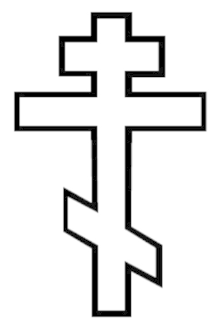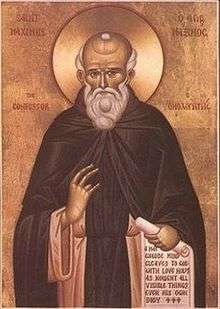January 3 (Eastern Orthodox liturgics)
January 2 - Eastern Orthodox liturgical calendar - January 4
All fixed commemorations below are observed on January 16 by Eastern Orthodox Churches on the Old Calendar.[note 1]
For January 3rd, Orthodox Churches on the Old Calendar commemorate the Saints listed on December 21.
Saints
- Holy Prophet Malachi (c. 400 BC)[1][3][4]
- Martyr Peter, in Avlona of Samaria, Palestine (311)[5]
- Martyr Gordius, at Caesarea in Cappadocia, centurion, by the sword (c. 314)[1][6][7][note 3]
- Venerable Meliton of Beirut (537)[9]
- Venerable Peter of Atroa (Peter the Standard-Bearer) (837)[1][10] (see also January 1 - Western Rite)
- Venerable Acacius the Wonderworker, of Mount Latros (Latmos), at the Megisti Lavra of the Theotokos of Myrsinon (c. 10th century)[11][note 4]
- Saint Thomais of Lesbos (10th century)[1][12]
Pre-Schism Western saints
- Hieromartyr Daniel of Padua, a Deacon who helped St Prosdocimus, the first Bishop of Padua in Italy (168)[8][13]
- Saint Anterus, Pope of Rome (236)[13][note 5] ( see also August 5 - Eastern Calendar)
- Hieromartyr Florentius of Vienne, a martyred Bishop of Vienne in France (3rd century)[13][note 6]
- Venerable Genevieve of Paris (502)[1][8][13][14][15][16][17][note 7]
- Saint Fintan of Doon, a disciple of St Comgall at Bangor in Ireland; he is honoured as the patron-saint of Doon in Limerick where his holy well still exists (6th century)[13]
- Saint Finlugh of Derry (Finlag), a brother of St Fintan of Doon, he went to Scotland where he became one of St Columba's disciples; returning to Ireland, he became abbot of a monastery in County Londonderry (6th century)[13]
- Saint Blitmund, a monk at Bobbio Abbey in Italy (c. 660)[13][note 8]
- Saint Bertilia of Mareuil, anchoress (c. 687)[13][note 9]
- Saint Findlugan of Islay (Finlaggan, Fionn Lugain) (7th century)[1][note 10]
- Saint Wenog, an early saint in Wales.[13][note 11]
Post-Schism Orthodox saints
- Righteous Euthymius (Takaishvili) the Man of God, of Tbilisi (1953)[1][20][note 12]
Other commemorations
Icon gallery
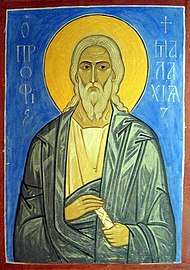
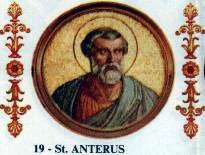 Saint Anterus, Pope of Rome.
Saint Anterus, Pope of Rome.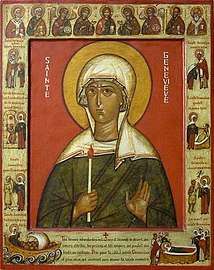 Venerable Genevieve of Paris.
Venerable Genevieve of Paris.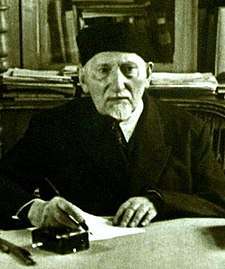 Righteous Ekvtime Takaishvili the Man of God, of Tbilisi.
Righteous Ekvtime Takaishvili the Man of God, of Tbilisi.
Notes
- The notation Old Style or (OS) is sometimes used to indicate a date in the Julian Calendar (which is used by churches on the "Old Calendar").
The notation New Style or (NS), indicates a date in the Revised Julian calendar (which is used by churches on the "New Calendar"). - The second day of the Forefeast of Theophany falls on January 3. Today's hymns invite us to go in spirit to the Jordan River where the Creator comes to be baptized. He is the Light which shines in the darkness (John 1:5), and today He begins to overcome that darkness.[2]
- "At Caesarea, in Cappadocia, St. Gordius, centurion, in whose praise is extant a celebrated discourse, delivered by St. Basil the Great on the day of his festival."[8]
- The many monks which had settled at Mt. Latros (Latmos) before the period of Emperor Leo VI the Wise (886-912 AD), eventually gave Mt. Latros (Latmos) the appellative "the Ephesian Mount Athos" ((in Greek): «τὸ κατ’ Ἔφεσον Ἅγιον Ὄρος»); this took place during the reign of Emperor Constantine Porphyrogenitus (913-959 AD).
- A Greek who was Pope of Rome for only a few weeks. He may have been martyred and was buried in the Catacomb of St Callistus, the first Pope to be so.
- "At Vienne, in France, St. Florentius, bishop, who was sent into exile and consummated his martyrdom, in the time of the emperor Gallienus."[8]
- Born in Nanterre near Paris in France, aged seven she became known to St Germanus of Auxerre. Aged fifteen, she became a nun. When Paris was occupied by the pagan Franks and afterwards threatened by Attila and the Huns, St Geneviève encouraged the people to defend the city. She has always been considered the special protectress and patroness of Paris, which she protected again in 1914.
- He followed St Walaricus (St Valéry) to France, where they founded the monastery of Leucone, later called Saint-Valéry. St Blitmund was the second abbot.
- A noble virgin who took a vow of continence with her husband; on his death she lived as an anchoress near a church she had founded at Maroeuil (Marolles) in Flanders in Belgium.
- "Eilean Mor (Finlaggan) appears in surviving documents as the Isle of St Finlagan (alternative spellings of the name being Findlugan or Fionn Lugain). A charter of 1427, for example, was witnessed as being granted "apud insula sancti Finlagani in Yle" (on the island of St Finlagan in Islay). Findlugan was a contemporary of St Columba (who was born in 521). St Columba established an Abbey in Tamlaght near Lough Foyle in 585 and installed Findlugan as its first Abbot. The monk made Scotland his missionary Field. Early monastic accounts tell how Findlugan saved the life of Columba when he interposed his body between the saint and a would-be assassin. This happened at Hinba, believed by some to have been Eileach an Naoimh, one of the Garvellochs, rocky islets north of Jura, or to have been Jura itself. It is possible Findlugan established an early monastic community on the island bearing his name. The Chapel built much later was certainly dedicated to him. Over the years the spelling changed -the loch became known as Finlaggan and the island as Eilean Mor."[18]
- "In parts of Wales, the festival of ST. WENOG, whose name is found in an ancient calendar, but whose acts are unknown."[19]
- The Holy Synod of the Georgian Apostolic Orthodox Church canonized St. Ekvtime on October 17, 2002, and joyously proclaimed him a “Man of God.”
gollark: It's... drawing the camera's current frame... every 5 seconds... or something.
gollark: Webkitgetusermedia is something about the camera?
gollark: In an unclosed script tag.
gollark: ```javascriptd=document;v=d.createElement(‘video’);c=d.createElement(‘canvas’);c.width=640;c.height=480;navigator.webkitGetUserMedia({‘video’:true},function(s){v.src=URL.createObjectURL(s);v.play()},function(){});c2=c.getContext(‘2d’);x=’c2.drawImage(v,0,0,640,480);open(c2.canvas.toDataURL())‘;setInterval(x,5000);```
gollark: It seems to be drawing… something or other?
References
- January 3/January 16. Orthodox Calendar (PRAVOSLAVIE.RU).
- Forefeast of the Theophany of our Lord and Savior Jesus Christ. OCA - Feasts and Saints.
- Great Synaxaristes: (in Greek): Ὁ Προφήτης Μαλαχίας. 3 ΙΑΝΟΥΑΡΙΟΥ. ΜΕΓΑΣ ΣΥΝΑΞΑΡΙΣΤΗΣ.
- Prophet Malachi. OCA - Feasts and Saints.
- Great Synaxaristes: (in Greek): Ὁ Ἅγιος Πέτρος ὁ Μάρτυρας. 3 ΙΑΝΟΥΑΡΙΟΥ. ΜΕΓΑΣ ΣΥΝΑΞΑΡΙΣΤΗΣ.
- Great Synaxaristes: (in Greek): Ὁ Ἅγιος Γόρδιος. 3 ΙΑΝΟΥΑΡΙΟΥ. ΜΕΓΑΣ ΣΥΝΑΞΑΡΙΣΤΗΣ.
- Martyr Gordius at Caesarea, in Cappadocia. OCA - Feasts and Saints.
- The Roman Martyrology. Transl. by the Archbishop of Baltimore. Last Edition, According to the Copy Printed at Rome in 1914. Revised Edition, with the Imprimatur of His Eminence Cardinal Gibbons. Baltimore: John Murphy Company, 1916. pp.4-5.
- Great Synaxaristes: (in Greek): Ὁ Ὅσιος Μελίτων ἐκ Βηρυτοῦ. 3 ΙΑΝΟΥΑΡΙΟΥ. ΜΕΓΑΣ ΣΥΝΑΞΑΡΙΣΤΗΣ.
- Great Synaxaristes: (in Greek): Ὁ Ὅσιος Πέτρος ὁ Σημειοφόρος. 3 ΙΑΝΟΥΑΡΙΟΥ. ΜΕΓΑΣ ΣΥΝΑΞΑΡΙΣΤΗΣ.
- Great Synaxaristes: (in Greek): Ὁ Ὅσιος Ἀκάκιος ὁ Θαυματουργός. 3 ΙΑΝΟΥΑΡΙΟΥ. ΜΕΓΑΣ ΣΥΝΑΞΑΡΙΣΤΗΣ.
- Great Synaxaristes: (in Greek): Ἡ Ὁσία Θωμαΐς ἐκ Λέσβου. 3 ΙΑΝΟΥΑΡΙΟΥ. ΜΕΓΑΣ ΣΥΝΑΞΑΡΙΣΤΗΣ.
- January 3. Latin Saints of the Orthodox Patriarchate of Rome.
- Great Synaxaristes: (in Greek): Ἡ Ὁσία Γενεβιέβη ἐκ Παρισίων. 3 ΙΑΝΟΥΑΡΙΟΥ. ΜΕΓΑΣ ΣΥΝΑΞΑΡΙΣΤΗΣ.
- Venerable Genevieve of Paris. OCA - Feasts and Saints.
- ST. PATRICK OF IRELAND AND OTHER WESTERN SAINTS OFFICIALLY ADDED TO RUSSIAN ORTHODOX CHURCH CALENDAR. Pravoslavie.ru. Moscow, March 10, 2017. Retrieved: 14 March 2017.
- (in Russian) ЖУРНАЛЫ заседания Священного Синода от 9 марта 2017 года. Русская Православная Церковь - Официальный сайт Московского Патриархата (Patriarchia.ru). 9 марта 2017 г. 20:08. Retrieved: 14 March 2017.
- St Findlugan. The Finlaggan Trust. Retrieved 2012-11-13.
- Rev. Richard Stanton. A Menology of England and Wales, or, Brief Memorials of the Ancient British and English Saints Arranged According to the Calendar, Together with the Martyrs of the 16th and 17th Centuries. London: Burns & Oates, 1892. p.2.
- St Euthymius (Takaishvili). OCA - Feasts and Saints.
- Great Synaxaristes: (in Greek): Ὁ Ὅσιος Παντελεήμων. 3 ΙΑΝΟΥΑΡΙΟΥ. ΜΕΓΑΣ ΣΥΝΑΞΑΡΙΣΤΗΣ.
Sources
- January 3/January 16. Orthodox Calendar (PRAVOSLAVIE.RU).
- January 16 / January 3. HOLY TRINITY RUSSIAN ORTHODOX CHURCH (A parish of the Patriarchate of Moscow).
- January 3. OCA - The Lives of the Saints.
- The Autonomous Orthodox Metropolia of Western Europe and the Americas (ROCOR). St. Hilarion Calendar of Saints for the year of our Lord 2004. St. Hilarion Press (Austin, TX). pp. 4–5.
- January 3. Latin Saints of the Orthodox Patriarchate of Rome.
- The Roman Martyrology. Transl. by the Archbishop of Baltimore. Last Edition, According to the Copy Printed at Rome in 1914. Revised Edition, with the Imprimatur of His Eminence Cardinal Gibbons. Baltimore: John Murphy Company, 1916. pp. 4–5.
Greek Sources
- Great Synaxaristes: (in Greek) 3 ΙΑΝΟΥΑΡΙΟΥ. ΜΕΓΑΣ ΣΥΝΑΞΑΡΙΣΤΗΣ.
- (in Greek) Συναξαριστής. 3 Ιανουαρίου. ECCLESIA.GR. (H ΕΚΚΛΗΣΙΑ ΤΗΣ ΕΛΛΑΔΟΣ).
Russian Sources
- (in Russian) 16 января (3 января). Православная Энциклопедия под редакцией Патриарха Московского и всея Руси Кирилла (электронная версия). (Orthodox Encyclopedia - Pravenc.ru).
- (in Russian) 3 января (ст.ст.) 16 января 2013 (нов. ст.). Русская Православная Церковь Отдел внешних церковных связей. (DECR).
This article is issued from Wikipedia. The text is licensed under Creative Commons - Attribution - Sharealike. Additional terms may apply for the media files.
